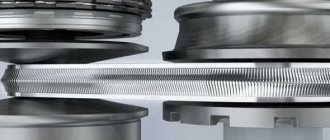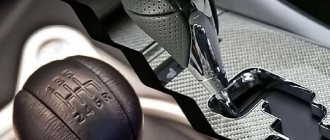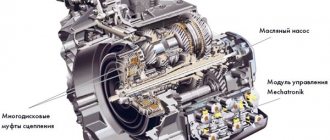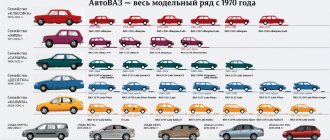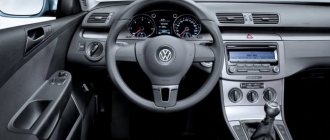When choosing a new car, the type of gearbox installed on it plays an important role. Today, all used transmissions can be divided into automatic and manual transmissions. What is each type of gearbox, what positive and negative characteristics do they have? Which of these transmissions will ultimately be better? We will examine these questions in the article.
Advantages of mechanics over automatic
- Only a driver who respects and feels the machinery can understand the beauty of driving with complete control of the car.
- You begin to love and understand manuals only when you have gained a fair amount of experience, but an automatic is for girls or novice drivers. It’s not for nothing that O was introduced into his driver’s license: he has mastered an automatic, which means he can’t drive a manual one. On the contrary - please.
- This is a technique for real aces, only they can squeeze out all its potential from the mechanics and make everyone on the track.
What to choose?
Everyone decides for himself what is best for him, especially since when buying a new car, the overpayment for an automatic transmission is not that big, and some models are not even available with a manual transmission. An automatic transmission will provide comfort, but excessive relaxation while driving does not lead to anything good. A manual transmission will allow you to fully control the car, but traveling in the city will be very exhausting.
Text: Natalya Khalezova
Photos from Internet resources
But this is all lyrics. But what about the fact?
I drove a Toyota Yaris 2009 for three years - manual. By the way, here she is.
I won’t say that I was very tired of changing gears; on the contrary, I even liked to be constantly on my toes. The road is completely under your control, all maneuvers depend only on your calculations and actions. I was the “automatic” there: decisions were made instantly, the clutch was squeezed and released, everything was worked out.
Mechanics: reliability and efficiency
A manual transmission is one of the oldest types of transmissions. Here the driver is directly involved in selecting a gear. Gear shifting is carried out by the driver using a gear selection mechanism and synchronizers, which is why the transmission is called a manual gearbox.
Scheme of a mechanical three-shaft gearbox
Driving usually starts in first gear, and subsequent gears are selected based on the current speed, engine speed and traffic situation. Gear shifting occurs when the engine and gearbox are disconnected using the clutch.
The torque in a manual transmission changes in steps, and accordingly the box itself is considered “stepped”. Depending on the number of gears, gearboxes are 4-speed, 5-speed, 6-speed and higher. The most popular is the 5-speed manual transmission.
Depending on the number of shafts, two-shaft and three-shaft manual transmissions are distinguished. The former are installed on front-wheel drive and rear-engine passenger cars with a transverse engine, the latter on rear-wheel drive and trucks with a longitudinal engine.
Is it necessary to depress the clutch when starting the engine on a manual transmission?
I treated automatic transmission without hostility and without fear. There's just no way. Well, people travel, to each his own. I didn’t understand one thing, how does it feel to give control to an automatic machine, instead of getting high yourself?
Therefore, when I bought the Toyota Avensis 2006, at first I was even upset that it was automatic. Well, the circumstances were such that it was necessary to take it. And, I think, I’ll drive it, if anything happens, I’ll sell it.
Well, what can I say: I was wrong. And many people say the same thing, I read auto forums: “I switched to an automatic, I’ll never go back to a manual,” I subscribe to every word.
Two men had a fight in the comments under a video about traffic violations - now one is in the morgue, and the other is in custody
Why such a sudden change? Everything is relative. I knew in what ways manual transmission was cooler, but in practice many points were not confirmed. For example, I didn’t notice increased fuel consumption.
Analogy
There is no clear answer to the question: which is better, manual transmission or automatic transmission?
To make the message of the material in question immediately clear, try comparing something simpler. For example, which is better:
- Pop or classical music?
- Instant coffee or beans?
- Movies or books?
- Saucepan or slow cooker?
Everything that comes first on this list is more common. But is it better than the second? It's impossible to say for sure. Surely you will agree with this on at least one point. But in order to fully compare anything, more criteria are needed. For example, coffee beans taste better than instant coffee. But it is more expensive, and to prepare it you need a coffee grinder with a Turk or a coffee machine. Books are more useful than films. But reading is more difficult than watching. Finally, it is more convenient to cook in a slow cooker, but it is at least three times more expensive than a saucepan.
It's the same with automatic and manual. Purely based on its prevalence, it is difficult to say unequivocally which is better. More criteria are needed. And in the case of automatic and manual transmissions there are plenty of them. Only 15 pieces are considered here. However, there is one catch. Many criteria for comparing automatic and manual are overgrown with myths and subjective opinions. For others, the balance has shifted as technology has advanced. In addition, for some, certain criteria are very important, while others, roughly speaking, don’t care about them.
Pros of mechanics
- Good acceleration and higher efficiency. The car can be made to take off or quickly accelerate. At the same time, on an automatic, the torque converter steers everything, it itself goes through the engine operating modes, choosing the optimal one, thereby extinguishing power and energy, the driver cannot do anything.
- A manual requires on average 3-5 times less oil than an automatic, and the price is lower per liter of oil.
- Quick winter start. I squeezed the clutch - the transmission from the engine was disconnected, and the car started easily. And the automatic, as we remember, is at the mercy of the torque converter - it is not disconnected from the engine in any way, and therefore it is more difficult to spin up the start.
- The mechanics are simpler in design and, therefore, cheaper to repair or cost used.
Automatic: comfort and convenience
Diagram of an automatic transmission
In an automatic transmission, the clutch function is assigned to the torque converter, and the electronic control unit and actuators are responsible for shifting gears: friction clutches, band brakes, etc.
The driver selects the operating mode of the automatic transmission and the direction of movement using the gear selector installed in the vehicle interior. When installing an automatic transmission on front-wheel drive passenger cars, the gearbox design is complemented by a final drive and a differential.
Modern automatic transmissions are adaptive, that is, their electronic system is equipped with a “memory” of the driver’s driving style. In less than an hour's drive, the automatic transmission will adapt to your driving style.
There are the following types of automatic transmissions: hydromechanical gearbox (classic automatic), manual transmission with two clutches, robotic gearbox and continuously variable transmission. But still, an automatic transmission always means a classic hydromechanical planetary gearbox.
And now my objections, based on personal experience:
- I’m not a fan of drifting and speeding up at traffic lights, so the power and quick acceleration of the manual turned out to be only a potential advantage for me, which was not useful to me. But, having driven tens of thousands of kilometers through city traffic jams, I appreciated how convenient it is when you don’t have to constantly grab the lever and press the clutch.
- Oil consumption is higher - I don’t deny this, but these are minor things. You need to change the oil on time and generally take care of the car, then there won’t be any wild oil leaks.
- In winter, I started up without much trouble even at -28°C - it couldn’t be colder, the climate is like that. And I calmly drive along the snow-covered, unclean road in a low gear, watching how the manual skids.
- Repairs are affordable in any case - be it manual or automatic. But if you operate it wisely and treat it with care, the machine will serve faithfully, and much longer than stated by the manufacturer.
Here's another observation. Outside the city, on off-road terrain, the automatic car also shows good cross-country ability. Contrary to the belief of the “mechanics”, the automatic transmission is capable of quickly changing gears, so I skipped even where the mechanics sat tightly.
Of course, I haven’t renounced manual transmission forever—I sometimes drive a company car with a manual transmission. I don’t think that changing gears is backbreaking work; the arms and legs remember and do their job.
But still, here is my firm opinion: any automatic transmission is much more comfortable than a manual one. When you've been driving for more than a hundred thousand kilometers, once you've tried something better, you won't want to go back to the worst.
Apply the gas brake, press it quietly and enjoy the ride, and don’t have to think about how many revolutions there are on the tachometer. You can consider it laziness or degradation - but I don’t care! Machines should be for people, not the other way around.
Automatic or manual transmission
Let us compare the two types of transmissions in terms of their advantages and disadvantages. We will take the following criteria as a basis: price, maintenance and repair, efficiency and acceleration, reliability, service life, winter driving conditions, comfort, clutch and engine life, and vehicle behavior on the road.
Price issue
An automatic transmission is more expensive than a manual transmission. And fuel consumption with an automatic transmission will be 10-15% higher than with a manual transmission. This mainly applies to city driving; outside the city, the difference in fuel consumption will be slightly less.
Maintenance and repair
Maintenance and repair of a car with an automatic transmission will be more expensive. An automatic requires more oil than a manual, and it costs more. The oil filter also requires replacement. Compared to an automatic transmission, a manual transmission is easy to maintain and does not require expensive consumables and spare parts.
Efficiency and acceleration
The acceleration dynamics of a manual transmission are better than those of an automatic transmission, and the efficiency of a manual transmission is higher. A manual transmission makes it possible to realize all the engine power and torque. The exception is robotic transmissions with two clutches.
Reliability
The simplicity of the device compared to an automatic transmission allows manual transmission to claim the title of a more reliable gearbox. Towing over long distances with a flexible or rigid hitch is only possible for vehicles with a manual transmission. It is recommended to transport a car with an automatic transmission only on a tow truck. The operation of a car equipped with a manual when driving in icy conditions, through mud and off-road will be better compared to an automatic.
Service life
And this criterion speaks in favor of mechanics, whose service life is longer. Some manual transmissions can function even after the original car engine fails. The same cannot be said about the automatic transmission, which will only last until overhaul.
Winter driving
It is easier to drive a manual car on slippery surfaces and skid in the snow. For an automatic machine, these actions are not advisable - the transmission oil may overheat.
So, for the six items under consideration (price, maintenance and repair, efficiency and acceleration, reliability, service life, winter driving conditions), a manual gearbox wins. Let's see how the machine responds.
Comfort
Automatic transmission operating modes
Automatic has a higher level of driver comfort than manual transmission. Even an inexperienced driver will be able to move off calmly and without jerking, without creating an emergency situation. Mechanics require increased concentration and attention from the driver. Constant gear changes and the need to constantly depress the clutch pedal, especially in city traffic jams, tire the driver.
Engine and clutch life
In this regard, the automatic also benefits: it controls the speed and prevents the engine from overheating. On a manual transmission, incorrect gear shifting may result in engine overload. Beginners may forget and fail to change gears from low to high in time, causing the engine to operate at higher speeds.
The same applies to the clutch. In a car equipped with an automatic transmission, there is no need to constantly disengage the clutch.
Car behavior on the road
A car with an automatic transmission moves smoothly, without jerking, and does not roll away on a hill. The machine has a “parking” mode, in which the engine is disconnected from the transmission and the output shaft of the box is mechanically locked. This mode allows the machine to be held securely in place.
Well, three against six! Is a manual better than an automatic? May be. But developers do not stand still and come up with new and increasingly improved varieties of automatic transmissions. If we take, for example, the acceleration of a car as a criterion, then a manual transmission accelerates faster than a classic automatic transmission, and a CVT transmission is definitely not inferior in efficiency to a manual transmission, and sometimes even surpasses it.
